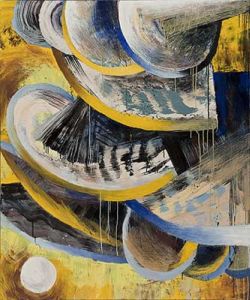 From Gary Faigin on Artdish:
From Gary Faigin on Artdish:
Lucinda Parker
speaks of taking her inspiration from nature, but Thoreau would have
had her thrown out of Walden Pond for disturbing the peace. Her big, noisy paintings are celebrations of energy, movement, and conflict. To the extent that they are inspired by the natural world, it is the realm of tsunamis, windstorms, icebergs, and waterfalls – force colliding with force.
Go, Gary. I love that lead.
Based in Portland, Oregon, the painter in question is well into the third decade of her career. Across time it’s easy to see relationships that weren’t
clear in the beginning.

 Although Parker had a brief flirtation with decorative effects,
Although Parker had a brief flirtation with decorative effects,
her strength is power painting: broad arcs of form crashing, folding or
curving into each other, cutting through space like knives through
thick batter.
Her work bears a relationship to the late Portland
painter Carl Morris: his sweeping arcs without his muddy color. And
like the paintings of Howard Hodgkin, hers
continue over the frame, refusing to acknowledge a beginning or end.
But Parker is blunter than either Morris or Hodgkin. At the
core of her abstraction is an interest in generative life processes,
which she presents in all their sour, messy glory.
When yellow hits black in a Hodgkin painting, the effect can be delicate. When the same colors meet in Parker’s spaces, that
convergence has a blunt and battering force.
She had a solo show last month at Linda Hodges Gallery in Seattle. In Portland, she’s represented by Laura Russo.



Nature means different things to different people. movement and energy are the ultimate form of nature in a way, particularly when shown outside of the more tangable human perceptions and reflections and expressed as raw elements. I don’t see Tsunamis and whirl winds.. I see every day life in her paintings. This is an expression of the norm, or nature.